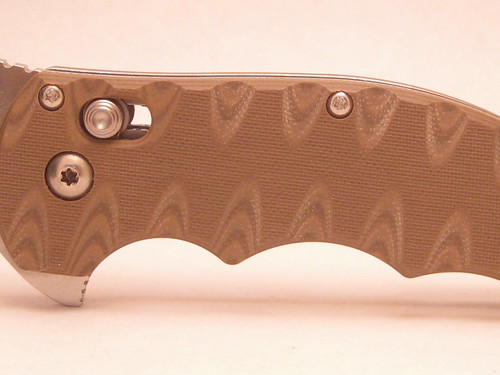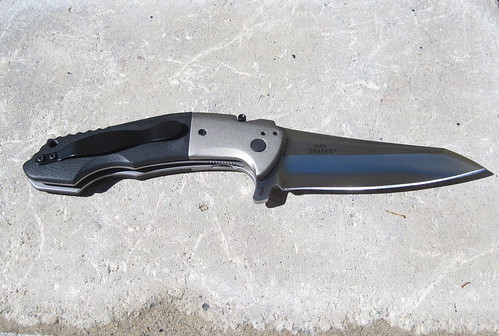Understanding Affordance
While on vacation I was reading my parent's Cook's Illustrated, which is one of my inspirations for writing reviews (along with EGM and Robert Parker). Their reviews are clear, concise, and grounded in facts. There is very little consideration given to brand or hype. One article, in particular, caught my eye. They were doing a chef knife comparison test. The article began by discussing how one certain knife had been the reigning champ of chef knives regardless of price for over 20 years. This knife had been stacked up against all sorts of competitors and each time, no matter how giant the hype or the price tag, this knife slayed them all. The knife is this knife:
One thing the article pointed out was how the simple handle was preferred by all of the testers. It seemed baffling that the simple curved shape trumped so-called ergonomic handles with fancy curves and cuts, divots for fingers, and special grippy rubber material. The reason why, according to the Cook's expert on ergonomics, was one idea: affordance.
Affordance is a term used by ergonomics folks, properly called human factors engineers, to describe how an object's design promotes its use. A door knob's design promotes twisting and pulling. Its shape and mechanisms afford these two different actions. Good, useful design affords more possible uses than bad design. Thus when considering what knife or light or piece of gear to buy it is crucial, if you want to maximize the utility of your gear, to understand affordance, even if you don't know what that word means (like I did up until about a week ago).
Finding out that there is a word and a line of thought devoted to this notion was tremendously surprising. I have had this idea in my head for a while and until I ran across this Cooks Illustrated article I didn't know there was a term for this. Affordance was just an idea without form. Now, it is something I can better process and explain in reviews.
Here is an example of me talking about affordance without knowing the word. In the Benchmade 300SN article I wrote this about the handle design:
This knife has, as mentioned above, a series of finger grooves. They happen to work for my hands, but in other, different sized hands they can be a problem. My Dad recently came into town and I handed him the knife and he did not like the handle at all. The finger grooves are a cheap and easy way to make something FEEL or SEEM ergonomic when it really isn't. The G10 was good as was the jimping, but I just couldn't get over the fact that this knife tells you how it MUST be held, instead of suggesting a number of ways it COULD be held.
This is EXACTLY the concept of affordance, I just didn't know it because, at the time I didn't know the word. To a trained eye, to someone that studies HFE, the grooved handle of the 300SN is an affordance disaster.
The product demands to be used in a certain way, instead of allowing multiple possible uses.
Now compare this to what I wrote about the CRKT Eraser:
No knife I have used as been as versatile in the hand as the Eraser. The forward grip is, of course, very nice with the flipper serving as an excellent hand guard. But it is the reverse grip (the ice pick grip) that is so extraordinary on the Eraser...Your finger lays in the groove easily and the ramp and jimping are perfectly placed. This knife's handle has made me re-examine other blades. Why is it that they can't match the Eraser in both grips? Why do we have to compromise when a solution like this is so elegant and useful? Best grip on any folder I have used thus far, despite my preference for small knives. This is truly a great design.
Here is the handle for the Eraser:
Again, I am talking around the concept of affordance, understanding what it means, but not knowing the word.
Strider PT, one of my favorite knife handles and for a long time I couldn't figure out why. Now armed with the concept of affordance, I can process what truly makes that silhouette one of the greatest knife handles of all time.
First, the two finger choils, one over the pivot and one behind it, allow for a choke up or choke down grip. The aggressive gearing (too big to be jimping) on the rear of the blade allows for a reverse grip with traction. Finally, the straight spine allows for precision grips with your pointer finger laid across the spin. In all, there are probably a half dozen ways to hold this smallish knife. The amazing design affords a bunch of different grips and uses.
The next time you pick up a light or a knife, think about affordance. Does this piece of gear demand a specific use or is open to how you need or want to use it? This is one thing that separates good design from great design--options and versatility. Affordance is one way to thing about options and versatility and it is a useful way to evaluate gear. Look for it in my future reviews. And look for it in your next gear purchase.
One thing the article pointed out was how the simple handle was preferred by all of the testers. It seemed baffling that the simple curved shape trumped so-called ergonomic handles with fancy curves and cuts, divots for fingers, and special grippy rubber material. The reason why, according to the Cook's expert on ergonomics, was one idea: affordance.
Affordance is a term used by ergonomics folks, properly called human factors engineers, to describe how an object's design promotes its use. A door knob's design promotes twisting and pulling. Its shape and mechanisms afford these two different actions. Good, useful design affords more possible uses than bad design. Thus when considering what knife or light or piece of gear to buy it is crucial, if you want to maximize the utility of your gear, to understand affordance, even if you don't know what that word means (like I did up until about a week ago).
Finding out that there is a word and a line of thought devoted to this notion was tremendously surprising. I have had this idea in my head for a while and until I ran across this Cooks Illustrated article I didn't know there was a term for this. Affordance was just an idea without form. Now, it is something I can better process and explain in reviews.
Here is an example of me talking about affordance without knowing the word. In the Benchmade 300SN article I wrote this about the handle design:
This knife has, as mentioned above, a series of finger grooves. They happen to work for my hands, but in other, different sized hands they can be a problem. My Dad recently came into town and I handed him the knife and he did not like the handle at all. The finger grooves are a cheap and easy way to make something FEEL or SEEM ergonomic when it really isn't. The G10 was good as was the jimping, but I just couldn't get over the fact that this knife tells you how it MUST be held, instead of suggesting a number of ways it COULD be held.
This is EXACTLY the concept of affordance, I just didn't know it because, at the time I didn't know the word. To a trained eye, to someone that studies HFE, the grooved handle of the 300SN is an affordance disaster.
The product demands to be used in a certain way, instead of allowing multiple possible uses.
Now compare this to what I wrote about the CRKT Eraser:
No knife I have used as been as versatile in the hand as the Eraser. The forward grip is, of course, very nice with the flipper serving as an excellent hand guard. But it is the reverse grip (the ice pick grip) that is so extraordinary on the Eraser...Your finger lays in the groove easily and the ramp and jimping are perfectly placed. This knife's handle has made me re-examine other blades. Why is it that they can't match the Eraser in both grips? Why do we have to compromise when a solution like this is so elegant and useful? Best grip on any folder I have used thus far, despite my preference for small knives. This is truly a great design.
Here is the handle for the Eraser:
Again, I am talking around the concept of affordance, understanding what it means, but not knowing the word.
Strider PT, one of my favorite knife handles and for a long time I couldn't figure out why. Now armed with the concept of affordance, I can process what truly makes that silhouette one of the greatest knife handles of all time.
First, the two finger choils, one over the pivot and one behind it, allow for a choke up or choke down grip. The aggressive gearing (too big to be jimping) on the rear of the blade allows for a reverse grip with traction. Finally, the straight spine allows for precision grips with your pointer finger laid across the spin. In all, there are probably a half dozen ways to hold this smallish knife. The amazing design affords a bunch of different grips and uses.
The next time you pick up a light or a knife, think about affordance. Does this piece of gear demand a specific use or is open to how you need or want to use it? This is one thing that separates good design from great design--options and versatility. Affordance is one way to thing about options and versatility and it is a useful way to evaluate gear. Look for it in my future reviews. And look for it in your next gear purchase.



